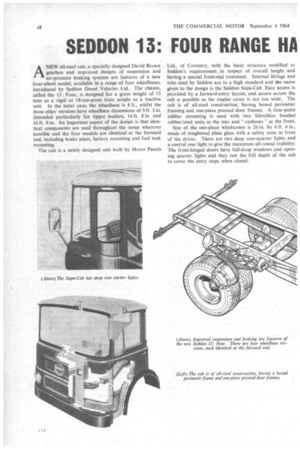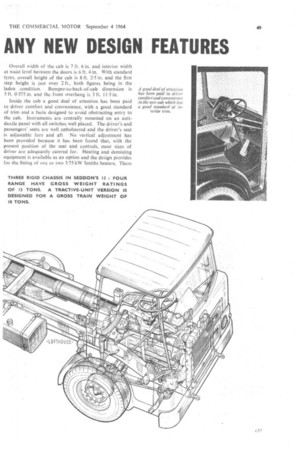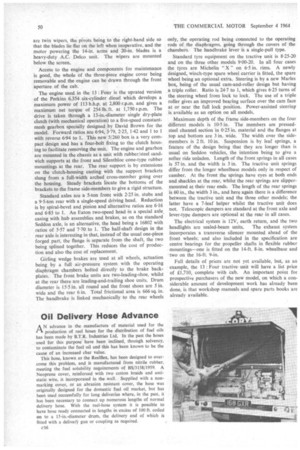SEDDON 13: FOUR RANGE HA ANY NEW DESIGN FEATURES
Page 50

Page 51

Page 52

If you've noticed an error in this article please click here to report it so we can fix it.
ANEW all-steel cab, a specially designed David Brown gearbox and improved designs of suspension and air-pressure braking systems are features of a new four-wheel model, available in a range of four wheelbases, introduced by Seddon Diesel Vehicles Ltd. The chassis, called the 13 : Four, is designed for a gross weight of 13 tons as a rigid or 18-ton-gross train weight as a tractive unit. In the latter case, the wheelbase is 8 ft., whilst the three other versions have wheelbase dimensions of 9 ft. 3 in. (intended particularly for tipper bodies), 14 ft. 8 in. and 16 ft. 9 in. An important aspect of the design is that identical components are used throughout the range wherever possible and the four models are identical at the forward end, including brake pipes, battery mounting and fuel tank mounting.
The cab is a newly designed unit built by Motor Panels Ltd., of Coventry, with the basic structure modified to Seddon's requirements .in respect of overall height and having a special front-end treatment. Internal fittings and trim used by Seddon are to a high standard and the name given to the design is the Seddon Supa-Cab. Easy access is provided by a forward-entry layout, and access across the cab is possible as the engine cover is not too wide. The cab is of all-steel construction, having boxed perimeter framing and one-piece pressed door frames. A four-point rubber mounting is used with two Silentbloc bonded rubber/steel units at the rear and " cushions " at the front.
Size of the one-piece windscreen is 26 in. by 6 ft. 6 in., made of toughened plate glass with a safety zone in front of the driver. There are two deep rear-quarter lights and a central rear light to give the maximum all-round visibility. The front-hinged doors have full-drop windows and opening quarter lights and they run the full depth of the cab to cover the entry steps when closed.
Overall width of the cab is 7 ft. 6 in. and interior width at waist level between the doors is 6 ft. 4 in. With standard tyres, overall height of the cab is 8 ft. 2.5 in. and the first step height is just over 2 ft., both figures being in the
laden . condition. Bumper-to-back-of-cab dimension is 5 ft. 0.375 in. and the front overhang is 3 ft. 11.5 in.
Inside the cab a good deal of attention has been paid to driver comfort and convenience, with a good standard of trim and a facia designed to avoid obstructing entry to the cab. Instruments are centrally mounted on an antidazzle panel with all switches well placed. The driver's and passengers' seats are well upholstered and the driver's seat is adjustable fore and aft. No vertical adjustment has been provided because it has been found that, with the present position of the seat and controls, most sizes of driver are adequately catered for. Heating and demisting equipment is available as an option and the design provides for the fitting of one or two 3.75 kW Smiths heaters. There
are twin wipers, the pivots being to the right-hand side so that the blades lie flat on the left when inoperative, and the motor powering the 14-in, arms and 20-in, blades is a heavy-duty A.C. Delco unit. The wipers are mounted below the screen.
Access to the engine and components for maintenance is good, the whole of the three-piece engine cover being removable and the engine can be drawn through the front aperture of the cab.
The engine used in the 13 : Four is the uprated version of the Perkins 6.354 six-cylinder diesel which develops a maximum power of 113 b.h.p. at 2,800 r.p.m. and gives a maximum net torque of 254 lb. ft. at 1,750 r.p.m. The drive is taken through a 13-in.-diameter single dry-plate clutch (with mechanical operation) to a five-speed constantmesh gearbox specially designed by David Brown for the model. Forward ratios are 6-94, 3.79, 2-25, 142 and Ito 1 with reverse 6.94 to 1. This new 5/260 box is a very compact design and has a four-bolt fixing to the clutch hous-. ing to facilitate removing the unit. The engine and gearbox are mounted in the chassis as a unit with rubber/steel sandwich supports at the front and Silentbloc cone-type rubber mountings at the rear. The rear support is by extensions on the clutch-housing casting with the support brackets slung from a full-width arched cross-member going over the housing. Steady brackets locate the bottoms of the brackets to the frame side-members to give a rigid structure.
Standard axles are a 5-ton front with 2.25 in. stubs and a 9.5-ton rear with a single-speed driving head. Reduction is by spiral-bevel and pinion and alternative ratios are 6-16 and 6.83 to 1. An Eaton two-speed head in a special axle, casing with hub assemblies and brakes, as on the standard Seddon axle, is an alternative, the head being a 16802 with ratios of 5.57 and 7.70 to 1. The half-shaft design in the rear axle is interesting in that, instead of the usual one-piece forged part, the flange is separate from the shaft, the two being splined together. This reduces the cost of production and also the cost of replacement.
Girling wedge brakes are used at all wheels, actuation being by a full air-pressure system with the operating diaphragm chambers bolted directly to the brake backplates. The front brake units are two-leading-shoe, whilst at the rear there are leading-and-trailing shoe units. Drum diameter is 15-5 in. all round and the front shoes are 5 in. wide and the rear 6 in. Total frictional area is 666 sq. in. The handbrake is linked mechanically to the rear wheels only, the operating rod being connected to the operating rods of the diaphragms, going through the covers of the chambers. The handbrake lever is a single-pull type.
Standard tyre equipment on the tractive unit is 8-25-20 and on the three other models 9-00-20. In all four cases the tyres are Michelin "X " on 6-5 in. rims. A newly designed, winch-type spare wheel carrier is fitted, the spare wheel being an optional extra. Steering is by a new Marles box, being of the usual cam-and-roller design but having a triple roller. Ratio is 24-7 to 1, which gives 6.25 turns of the steering wheel from lock to lock. The use of a triple roller gives an improved bearing surface over the cam face at or near the full lock position. Power-assisted steering is available as an option on all models.
Maximum depth of the frame side-members on the four different models is 10.5 in. The members are pressedsteel channel section in 0.25 in. material and the flanges at top and bottom are 3 in. wide. The width over the sidemembers is 2 ft. 10 in. Suspension is by leaf springs, a feature of the design being that they are longer than is usual on Seddon vehicles, the intention being to give a softer ride unladen. Length of the front springs in all eases is 57 in. and the width is 3 in. The tractive unit springs differ from the longer wheelbase models only in respect of camber. At the front the springs have eyes at both ends and shackles at the rear, whilst the rear springs are slippermounted at their rear ends. The length of the rear springs is 60 in., the width 3 in., and here again there is a difference between the tractive unit and the three other models; the latter have a 7-leaf helper whilst the tractive unit does not. Telescopic dampers are standard at the front axle and lever-type dampers are optional at the rear in all cases.
The electrical system is 12V, earth return, and the two
headlights are sealed-beam units. The exhaust system incorporates a transverse silencer mounted ahead of the front wheels; and also included in the specification are centre bearings for the propeller shafts in flexible rubber mountings—one is fitted on the 14-ft. 8-in, wheelbase and • two on the 16-ft. 9-in.
Full details of prices are not yet available, but, as an example, the 13 : Four tractive unit will have a list price of £1,710, complete with cab. An important point for prospective purchasers of the new model, on which a considerable amount of development work has already been done, is that workshop manuals and spare parts books are already available.
































































































































